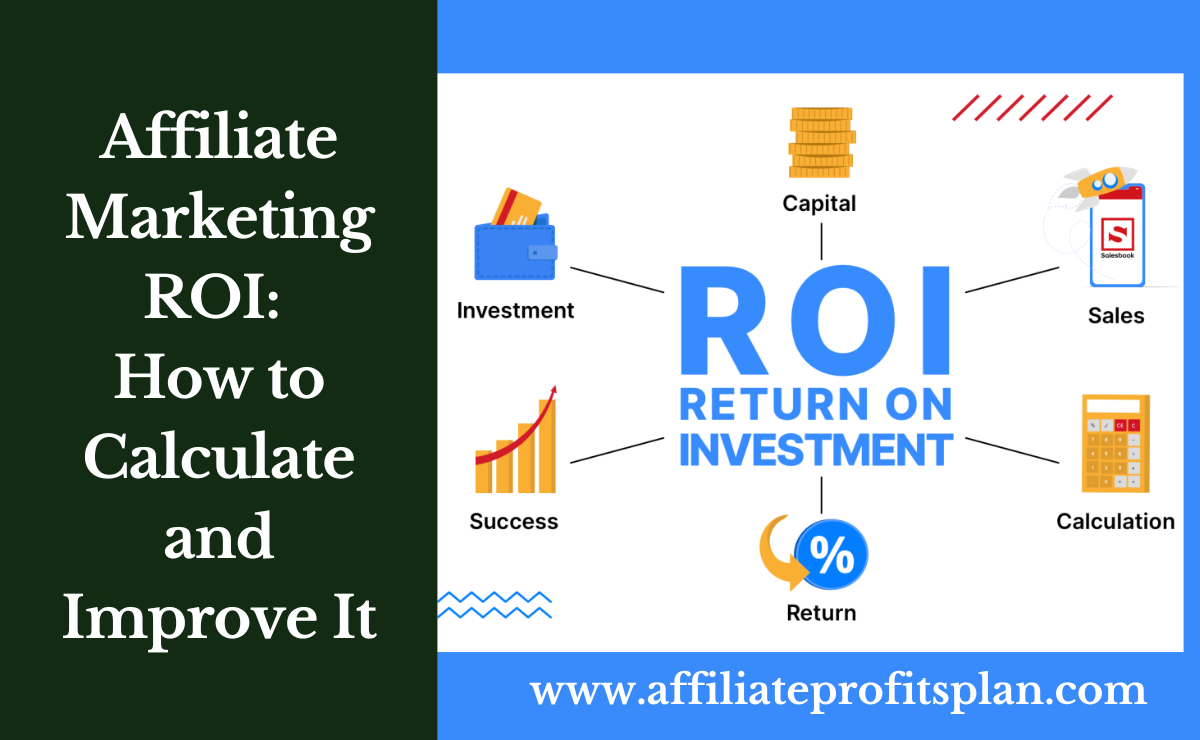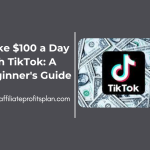Welcome to my article “Affiliate Marketing ROI: How to Calculate and Improve It” In the world of affiliate marketing, ROI isn’t just another three-letter acronym to toss around in conversations to sound smart. Nope, it’s the make-or-break metric that determines whether your affiliate campaigns are lighting up your bank account—or draining it faster than a subscription service you forgot to cancel.
Think of ROI (Return on Investment) as your campaign’s report card. It tells you how much profit you’re squeezing out of every dollar you spend. And let’s be real: while affiliate marketing is often marketed as “passive income,” there’s nothing passive about hemorrhaging money on campaigns that barely break even. You’re not here to fund someone else’s yacht; you’re here to get your slice of the digital pie.
But calculating ROI isn’t just about crunching numbers. It’s about understanding the bigger picture: where your traffic is coming from, how well it’s converting, and which products are making you the most bang for your buck. And if your current ROI is looking like a sad, flat line on a graph, don’t worry—you’re not alone. Most affiliate marketers have been there, staring at their stats and questioning their life choices.
In this guide, we’ll not only show you how to calculate your affiliate marketing ROI but also share some tried-and-tested strategies to boost it. So grab your calculator (or, let’s be honest, open your favorite tracking tool), and let’s turn those campaigns from “meh” to “money-making machine.” Because affiliate marketing should be about profits, not just pretty pie charts. Ready? Let’s dive in!
Access Our Proven Tested Formula for $50-$100 Daily Income – Watch This FREE Video >>

What Is Affiliate Marketing ROI and Why Is It Important?
Affiliate Marketing ROI (Return on Investment) is the ultimate scoreboard for your campaigns. Think of it as the digital equivalent of finding out whether that gym membership you’ve been paying for all year is actually working—or if you’ve just been contributing to your trainer’s vacation fund. In simple terms, ROI measures how much profit you’re making compared to how much you’re spending. The formula? It’s as straightforward as it gets:
ROI = (Revenue – Costs) ÷ Costs × 100%
For example, if you spent $500 on ads to promote a product and earned $1,000 in commissions, your ROI would be a sweet 100%. That’s right—you doubled your money. But if you’ve spent $500 and only made $250 back, well, let’s just say it’s time to rethink your strategy (or maybe blame Mercury retrograde).
So, why is ROI important? Because affiliate marketing isn’t just about slapping links on your blog or spamming social media with “Buy this now!” posts. It’s about being strategic—investing your time, money, and energy where they’ll give you the best returns. ROI helps you figure out what’s working and what’s not, so you’re not throwing cash into the marketing abyss and praying for a miracle.
Tracking your ROI also keeps you grounded. Sure, affiliate programs and gurus might promise six-figure incomes, but without knowing your ROI, you could be spending more than you’re earning. And let’s be real: nobody got rich by making $2 in commission for every $10 spent.
Bottom line? Knowing your ROI isn’t just important—it’s essential. It’s your compass in the chaotic world of affiliate marketing, guiding you toward campaigns that actually pay off. And hey, once you start seeing a healthy ROI, you can finally justify that extra-large coffee order or a celebratory treat. You earned it!
How to Calculate Affiliate Marketing ROI
Calculating your Affiliate Marketing ROI isn’t rocket science—it’s basic math, but with a lot more emotional highs and lows attached. The formula is simple:
ROI = (Revenue – Costs) ÷ Costs × 100%
Let’s break this down step by step, so even if you haven’t touched a calculator since high school, you’ll feel like a pro:
Step 1: Total Up Your Revenue
First things first—how much money are you making from your affiliate campaigns? This includes commissions from product sales, leads, clicks, or whatever action you’re being paid for. Think of it as your campaign’s paycheck, minus the part where it complains about taxes.
For example, if you’re promoting a fancy blender and earn $50 every time someone buys it through your affiliate link, and you’ve sold 20 of them, your total revenue is $1,000. Nice, right?
Step 2: Add Up Your Costs
Now comes the less fun part—figuring out how much you spent to make that money. Costs can include:
- Ad Spend: That Facebook or Google Ads campaign you launched to drive traffic.
- Software Fees: Tools like ClickFunnels, email marketing platforms, or tracking software.
- Content Creation Costs: Paying for blogs, videos, or graphics to promote the products.
- Affiliate Network Fees: Some networks take a cut, so don’t forget to factor this in.
If you spent $200 on ads, $50 on tools, and $50 on content, your total cost is $300.
Step 3: Plug It Into the Formula
Let’s do the math:
- Revenue = $1,000
- Costs = $300
- ROI = ($1,000 – $300) ÷ $300 × 100% = 233%
This means for every dollar you spent, you earned $2.33 in profit. Not bad at all!
Step 4: Track Regularly and Analyze
ROI isn’t a one-and-done deal. Your campaigns are constantly evolving—new products, updated ad strategies, and shifting audience interests. Make it a habit to calculate ROI regularly (weekly, monthly, or per campaign) to spot trends and make informed decisions.
Common Factors That Affect ROI in Affiliate Marketing
Affiliate marketing ROI isn’t some mystical number that appears out of thin air—it’s influenced by a mix of factors, some you can control and others that feel like they’re controlled by the universe itself (hello, algorithm updates). If your ROI isn’t where you want it to be, chances are one or more of these key elements is throwing off your game. Let’s break them down so you can identify the culprits and turn things around.
1. Product Quality and Demand
You could be the world’s best marketer, but if you’re promoting a product nobody wants—or worse, a product that’s getting 1-star reviews faster than you can refresh the page—your ROI is going to suffer. High-quality, in-demand products not only convert better but also lead to happier customers, fewer refunds, and more repeat buyers.
2. Traffic Quality
Not all traffic is created equal. Sure, you can drive a ton of clicks from bargain hunters or bots (yikes), but if your audience isn’t genuinely interested in the product you’re promoting, conversions will tank. A high volume of untargeted traffic might look good on paper, but it’s a fast-track to a lousy ROI.
3. Conversion Rates
You’ve done the hard work of getting people to your affiliate link, but if they’re not converting, it’s like inviting guests to a party and running out of snacks. Low conversion rates are an ROI killer, often caused by poorly designed landing pages, unclear CTAs (call-to-actions), or even a bad user experience on the merchant’s website.
Fix It Fast:
- A/B test headlines, images, and CTAs to see what resonates.
- Ensure the landing page aligns with the expectations you set in your content or ads.
- If the merchant’s site is the issue, consider switching to a similar product with a better sales funnel.
4. Commission Structure
Not all affiliate programs are created equal. Some offer generous commissions that make your ROI skyrocket, while others give you peanuts (and not even the salted kind). Whether it’s CPA (cost-per-action), CPS (cost-per-sale), or CPC (cost-per-click), the structure can significantly affect your profitability.
What to Watch For:
- High-ticket products (with higher payouts) can boost ROI even if the sales volume is lower.
- Recurring commission programs are gold—think subscription services that pay you monthly.
5. Ad Costs and Budget Mismanagement
If you’re running paid ads, the costs can spiral out of control faster than a toddler on a sugar rush. Overpaying for keywords, targeting the wrong audience, or running ads with low click-through rates (CTR) can eat into your profits and leave your ROI gasping for air..
6. Niche Competition
Let’s face it: affiliate marketing is a crowded field. If you’re in a super-competitive niche (think weight loss, finance, or tech), standing out can feel like shouting into the void. The higher the competition, the harder (and more expensive) it can be to drive traffic and conversions, which directly impacts ROI.
Access Our Proven Tested Formula for $50-$100 Daily Income – Watch This FREE Video >>
Work Smarter, Not Harder:
- Find sub-niches or unique angles to target.
- Focus on building trust and authority in your niche to stand out.
- Explore less-saturated platforms like Pinterest or TikTok if your niche audience is active there.
7. Refunds and Chargebacks
Imagine this: You’ve made a sale, celebrated with a happy dance, and then… bam! Refund request. Chargebacks and refunds don’t just hurt your ego; they directly impact your earnings and tank your ROI.
Prevention Tips:
- Promote products with low refund rates (ask affiliate managers for stats).
- Set clear expectations in your content to avoid misleading buyers.
8. Platform or Algorithm Changes
Ah, the dreaded algorithm updates—those sneaky changes by Google, Facebook, or Instagram that can mess up your traffic overnight. If your organic traffic drops or your ad costs suddenly spike, your ROI could take a nosedive.
Stay Ahead:
- Diversify your traffic sources to avoid over-reliance on a single platform.
- Stay updated on algorithm changes and adjust strategies accordingly.
Proven Strategies to Improve Affiliate Marketing ROI
If your affiliate marketing ROI isn’t exactly giving you “I’m a genius” vibes, don’t worry—you’re not alone. The good news? There are plenty of proven strategies to take your ROI from “meh” to “wow.” Let’s dive into some actionable tactics that can turn your affiliate campaigns into profit machines.
1. Laser-Focus on Your Target Audience
One-size-fits-all marketing doesn’t work—unless you’re selling plain white T-shirts. To improve your ROI, you need to know your audience better than they know themselves. What do they want? What keeps them up at night? What’s their favorite way to waste time online?
How to Nail It:
- Use Analytics: Platforms like Google Analytics and social media insights can reveal demographics, interests, and behaviors.
- Create Buyer Personas: Build profiles of your ideal customers to tailor content and offers to their specific needs.
- Engage in Communities: Hang out in niche forums, Facebook groups, or Reddit threads to understand your audience’s pain points and desires.
2. Optimize Your Content for Conversions
Great content isn’t just informative; it’s persuasive. If your blog posts or videos are attracting traffic but not driving clicks, your ROI will look like it skipped leg day.
Content Makeover Checklist:
- Use attention-grabbing headlines (because nobody clicks on “Top 10 Blender Reviews” when “This Blender Makes Smoothies AND Margaritas” exists).
- Write clear, compelling CTAs that guide readers to take the next step.
- Add visual elements like product demos, comparison charts, or testimonials to build trust.
- Structure content for easy scanning—think short paragraphs, bullet points, and subheadings.
3. Diversify Your Traffic Sources
Relying on a single traffic source is like putting all your chips on one roulette number—not a smart move. If one platform changes its algorithm, your traffic (and ROI) could vanish faster than leftover cake in an office breakroom.
Spread the Love:
- Organic Traffic: Optimize your site for SEO to attract free, high-quality traffic from search engines.
- Social Media: Use platforms like TikTok, Pinterest, and Instagram to reach niche audiences.
- Email Marketing: Build a list of subscribers you can nurture and convert over time.
- Paid Ads: Test different ad platforms (Google, Facebook, or even YouTube) to see which delivers the best ROI.
4. Promote High-Quality, High-Converting Products
If you’re promoting products that wouldn’t impress even your mom, it’s time to reevaluate. The right product can make or break your ROI.
Here’s How to Choose Wisely:
- Look for products with a proven track record of sales and low refund rates.
- Prioritize products with recurring commissions (hello, subscription services!).
- Check merchant landing pages—if they look like they were designed in 1999, move on.
5. A/B Test Everything
If you’re not testing, you’re guessing. And guessing isn’t exactly a reliable strategy for improving ROI. A/B testing allows you to find out what’s really working (and what’s just taking up space).
What to Test:
- Headlines and CTAs: Even a minor tweak can boost conversions.
- Landing Pages: Experiment with layouts, colors, and imagery.
- Ad Copy: Test different messaging to see what resonates with your audience.
- Email Subject Lines: Improve your open rates by testing different hooks.
6. Leverage Retargeting
Let’s face it—not everyone will convert on their first visit. But that doesn’t mean they’re a lost cause. Retargeting ads are like polite reminders: “Hey, remember that awesome product you almost bought? It’s still here!”
How to Use Retargeting Effectively:
- Retarget website visitors who clicked on your affiliate links but didn’t make a purchase.
- Offer discounts or limited-time deals to encourage conversions.
- Use platforms like Facebook, Google Ads, or even TikTok for retargeting campaigns.
7. Build an Email Funnel
Email marketing isn’t just alive—it’s thriving. Building an email funnel lets you nurture potential buyers, educate them about your offers, and drive conversions over time.
Steps to Create a Killer Funnel:
- Offer a lead magnet (e.g., a free guide or cheat sheet) to get people on your list.
- Send value-packed emails that educate and entertain.
- Gradually introduce affiliate products with clear benefits and strong CTAs.
- Follow up with scarcity-driven emails like “Last chance to save 20%!”
8. Track and Optimize Your Campaigns
If you’re not tracking your results, improving ROI is like trying to bake a cake without measuring the ingredients—you’ll end up with a mess.
Tools to Help You Stay on Top:
- Google Analytics: Track traffic, conversions, and user behavior.
- Affiliate Dashboards: Most affiliate programs have built-in analytics for performance tracking.
- Dedicated Tools: Platforms like Voluum or ClickMagick can provide detailed campaign insights.
Once you have the data, optimize ruthlessly:
- Cut underperforming campaigns.
- Double down on what’s working.
- Keep testing new strategies to stay ahead.
Access Our Proven Tested Formula for $50-$100 Daily Income – Watch This FREE Video >>
9. Build Trust with Your Audience
People don’t buy from strangers—they buy from people (or brands) they trust. If your audience doesn’t see you as credible, your ROI will take a nosedive.
Ways to Build Trust:
- Be transparent about your affiliate relationships.
- Only promote products you genuinely believe in (and, ideally, have used yourself).
- Engage with your audience through comments, social media, or email replies.
Tools and Metrics to Track Affiliate Marketing ROI
You wouldn’t drive cross-country without a GPS (or at least Google Maps), right? Well, affiliate marketing is no different. To get where you want to go (higher ROI land), you need tools and metrics to guide your journey. Thankfully, you don’t have to be a data scientist to track your affiliate marketing ROI—you just need the right toolkit and a sprinkle of curiosity. Let’s unpack the essentials.
1. Start With the Basics: Google Analytics
Google Analytics is the Swiss Army knife of tracking tools. It helps you monitor traffic, conversions, and user behavior—all essential for understanding your ROI.
What to Track in Google Analytics:
- Traffic Sources: Are people finding your site through organic search, social media, or referrals?
- Bounce Rate: If visitors are leaving faster than you can say “affiliate link,” your landing page may need work.
- Conversion Goals: Set up goals to track how many users click your affiliate links or complete a purchase.
- Time on Page: If your audience isn’t sticking around, your content might need more pizzazz.
2. Affiliate Program Dashboards
Most affiliate programs—like Amazon Associates, ClickBank, or ShareASale—offer built-in analytics. While they won’t give you the entire ROI story, they’re great for tracking direct metrics like clicks, sales, and commissions.
What to Look For:
- Clicks: How many people are clicking your affiliate links?
- Conversion Rates: What percentage of those clicks are turning into sales?
- Earnings Per Click (EPC): This metric shows how much you’re earning per click on average.
- Refund Rates: If you’re promoting products with high refund rates, your ROI will suffer.
3. Use Dedicated Tracking Tools
If you’re serious about affiliate marketing, consider investing in a dedicated tracking platform. These tools provide advanced analytics and give you a granular view of your campaigns.
Top Tracking Tools:
- Voluum: Ideal for affiliate marketers running multiple campaigns. It tracks everything from traffic sources to conversions.
- ClickMagick: A beginner-friendly tool for tracking clicks, split-testing campaigns, and optimizing funnels.
- Post Affiliate Pro: Combines tracking with affiliate management features, making it great for scaling.
What Makes These Tools Valuable?
- Detailed reporting (e.g., device types, geographic locations).
- Real-time tracking to adjust campaigns on the fly.
- Split-testing capabilities to see what’s working (and what’s not).
4. Metrics You Can’t Afford to Ignore
Let’s face it: If you’re not tracking the right metrics, you’re basically throwing spaghetti at the wall and hoping something sticks. Here are the must-know metrics for measuring affiliate ROI:
- Return on Investment (ROI): The granddaddy of all metrics. Use the formula:
ROI=(Revenue−Costs)Costs×100 ROI = \frac{(Revenue – Costs)}{Costs} \times 100 - Customer Lifetime Value (CLV): How much revenue can you expect from a single customer over time? Higher CLV = better ROI.
- Cost Per Acquisition (CPA): How much are you spending to acquire each customer?
- Average Order Value (AOV): Bigger orders mean bigger commissions, so focus on products or services with high AOVs.
- Click-Through Rate (CTR): This metric shows how engaging your content is. A low CTR means it’s time to revamp your CTAs or content.
5. Keep Tabs on SEO Performance
SEO isn’t just for traffic—it’s for ROI. Tools like Ahrefs, SEMrush, and Moz can help you track keyword rankings, backlinks, and organic traffic growth.
Key SEO Metrics to Monitor:
- Organic Traffic: Free traffic is the best kind of traffic, and it boosts ROI big time.
- Keyword Rankings: Are your affiliate-related keywords climbing the SERPs?
- Backlinks: High-quality backlinks can boost domain authority and attract more traffic to your affiliate pages.
- Click-Through Rate (CTR): Your meta titles and descriptions should entice clicks.
Pro Tip: Use tools like Google Search Console to find and fix issues like low-performing keywords or technical SEO problems.
6. Social Media Analytics for Affiliate ROI
If you’re promoting affiliate products on social platforms, don’t forget to track their performance. Most platforms (e.g., Facebook, Instagram, TikTok) offer built-in analytics to measure engagement and traffic.
What to Measure:
- Link Clicks: How many people are clicking your affiliate links from posts, stories, or bios?
- Engagement Rates: High likes and shares are great, but clicks are what pay the bills.
- Follower Demographics: Are you reaching the right audience for your niche?
7. Heatmaps and User Behavior Tools
Ever wonder why people aren’t clicking on your perfectly placed affiliate links? Heatmaps and user behavior tools like Hotjar or Crazy Egg can provide insights into how visitors interact with your site.
What They Reveal:
- Click Patterns: Are visitors ignoring your CTAs?
- Scroll Depth: Are they reading your content or bouncing halfway through?
- Session Recordings: Watch real-time replays of user interactions to spot potential issues.
Conclusion: Turning Data Into Dollars
And there you have it—your ultimate guide to mastering affiliate marketing ROI. Calculating ROI might feel like trying to decipher ancient hieroglyphics at first, but with the right tools, strategies, and a dash of humor, it becomes second nature. The key takeaway? Numbers don’t lie. They’re your GPS, your treasure map, and sometimes, your wake-up call (looking at you, high CPA campaigns).
Improving your ROI isn’t about throwing spaghetti at the wall and hoping it sticks; it’s about being intentional. Whether you’re tweaking your content, refining your traffic sources, or experimenting with new affiliate products, every small adjustment brings you closer to profitability. And don’t forget—patience is a virtue in affiliate marketing. ROI doesn’t skyrocket overnight, but with consistent effort and smart tracking, it will grow.
Access Our Proven Tested Formula for $50-$100 Daily Income – Watch This FREE Video >>
Remember, tools like Google Analytics, affiliate dashboards, and tracking software are your secret weapons. Use them to gather insights, but don’t just collect data—act on it. Look at what’s working and do more of that. Spot what’s not working and either fix it or ditch it. Think of your affiliate marketing strategy as a garden: water the plants that thrive and weed out the ones that don’t.
Finally, don’t let the numbers intimidate you. ROI is not just about profitability; it’s about learning what your audience loves and delivering it in the best way possible. Stay curious, stay adaptable, and don’t forget to celebrate those small wins along the way. After all, every commission earned, no matter how small, is proof that your efforts are paying off—literally.
So go ahead, crunch those numbers, tweak those campaigns, and watch your affiliate marketing ROI climb higher than your caffeine intake on launch day. You’re in control of your success, and with the tips and tools from this guide, you’ve got everything you need to make affiliate marketing work for you. Now, get out there and turn those clicks into cash!
Thanks a lot for reading my article on “Affiliate Marketing ROI: How to Calculate and Improve It″ till the end. Hope you’ve helped. See you with another article.










